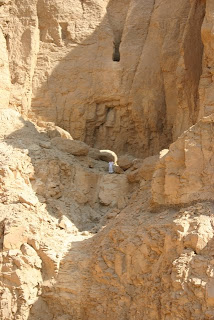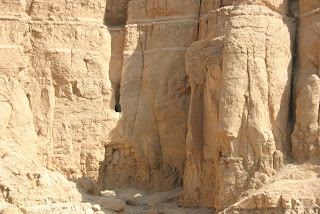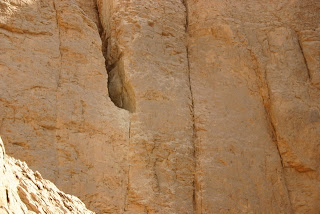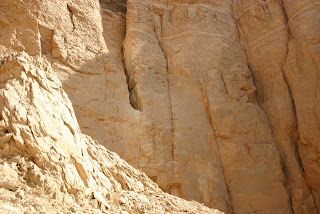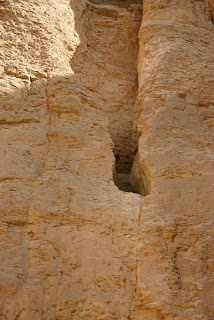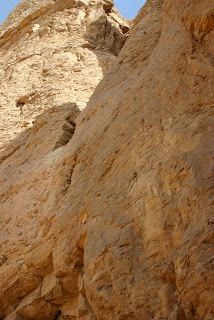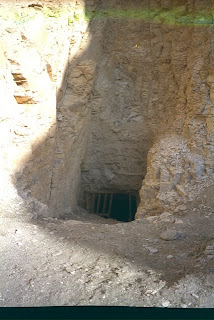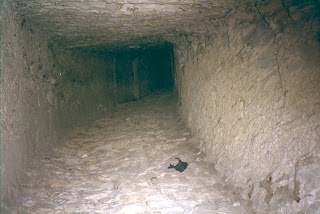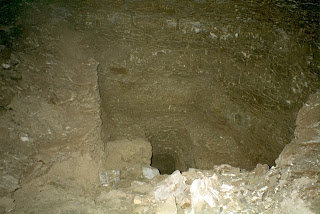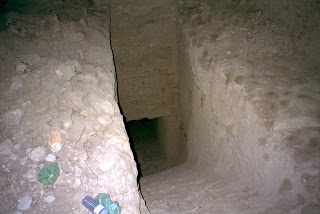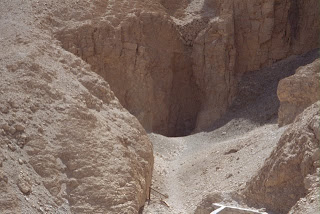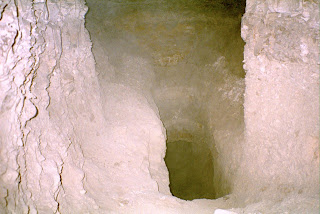Howard Carter's notes made in preparation of the final publication of the tomb of Tutankhamun can now be seen on the website of the Griffith Institute. Go to http://www.griffith.ox.ac.uk/gri/2.html
Jaromir Malek
Editor of the Topographical Bibliography and Keeper of the Archive
Tuesday 30 November 2010
Saturday 27 November 2010
Al-Ahram Weekly | Heritage | Never bettered, never better
Great article about my favourite Luxor team, Chicago House Al-Ahram Weekly | Heritage | Never bettered, never better: "Never bettered, never better
As the Epigraphic Survey at Chicago House in Luxor enters its 87th six-month season in Luxor, Jill Kamil talks to director Ray Johnson about the work in progress
Click to view caption
Clockwise: Medinet Habu blockyard moving, coordinated by conservator Lotfi Hassan; conservator Hiroko Kariya preparing display group; Khonsu Temple epigraphic team Brett McClain, Jen Kimpton, and Keli Alberts puzzle over an inscribed block; open-air museum at Luxor Temple
'Preserving Egypt's ancient records for present and future generations is what we strive to do,' says Ray Johnson, director of Chicago House, the iconic home of the University of Chicago's Oriental Institute archaeological team in Luxor. Johnson says that the documentation techniques pioneered by founder James Henry Breasted, while now augmented with new digital tools, have never been surpassed. 'When a photograph or a scan is not clear enough, or the wall surface is terribly damaged, we use non-invasive photographic and digital images as the basis for precise line drawings that continue to set the standard for epigraphic recording everywhere,' he says. 'This technique has become known simply as the Chicago House method, and it still sets the disciplined and meticulous course of the work of our documentation teams.
'We use many different techniques for recording inscribed stone surfaces, depending on the condition of the stone. In hard-to-reach areas aluminium-foil rubbings have proven to be tremendously useful, as is tracing with film on well-preserved surfaces when photography is not possible. We have lots of important projects in the pipeline,' Johnson adds. 'Among the primary sites where we work with the SCA are the Medinet Habu temple complex; the Eighteenth-Dynasty sections of Luxor Temple; Khonsu Temple at Karnak and even a private tomb from the time of Amenhotep III.'
Having conscientiously followed work in progress in Luxor over decades, and having perused the published results of the work completed by the Epigraphic Survey, all of which, by the way, are now available for free PDF download from the Oriental Institute Publications website, (just click 'Egypt' for all the titles), I quite naturally asked myself what remained to be done. Johnson must have anticipated such a question because he proceeds to tell me that 'there are literally kilometres of inscribed wall surfaces in Luxor that have never been properly recorded.' He also tells me about Chicago House's 'exciting new collaboration with the American Research Centre in Egypt, part of its USAID- funded East Bank Groundwater Lowering Response Initiative.'
Does my face register a blank at his words? Perhaps, because he goes on to explain that after the Luxor east bank dewatering program (sponsored by the SCA, USAID, and Sweden) was activated in 2006, the system effectively lowered the groundwater passing beneath Luxor and Karnak Temples by as much as three metres, thereby slowing down the groundwater salt decay of those structures. 'This has enabled follow-up conservation at the sites,' he says, adding that the training of Egyptian SCA conservators has been coordinated by ARCE during the last few years with a special grant from USAID.
'Chicago House is currently assisting ARCE in a floor restoration project at Khonsu Temple in Karnak, which involves replacing missing paving stones along the main axis of the temple that were quarried away in late antiquity -- and which made visiting the site difficult.' Johnson explains that Ramesses III built this temple out of the blocks from half a dozen temples that he dismantled and reused for this purpose, and that, 'luckily for us', in the interests of construction speed his workmen intentionally neglected to erase their original inscribed surfaces.
'As a result almost every block in the temple has earlier decoration preserved on one or more faces, and the floor and foundation stones are no exception. When an area where paving stones are missing is cleared, and earlier inscribed blocks are exposed, my team carefully records the earlier carving before thenew paving stones go in and conceal that information forever.'
Johnson's keen interest in the work in hand registers in the enthusiasm with which he speaks. 'It's a once in a lifetime opportunity and there have been lots of surprises,' he says, 'for instance the team has discovered that most of the floor blocks appear to be from an earlier Eighteenth- Dynasty Khonsu temple, thus providing a new and hitherto unknown chapter in the history of mighty Karnak'. It strikes me that Breasted would have been inordinately happy to know of this re-cycling process, and the care with which the Chicago House team is recording every scrap of information while it is accessible.
But that's not all. With support from ARCE, USAID, and now the World Monuments Fund, Chicago House has sponsored what is known as the Luxor Temple blockyard conservation programme. 'It has been going on for almost 20 years,' says Johnson. 'As environmental conditions changed in Luxor, with increasing humidity and higher groundwater, the decay of the monuments we were documenting accelerated and we recognised the need to expand our programme to include conservation and restoration. So we applied for special grants for that purpose'.
The culmination of the Luxor Temple fragment programme is a new open-air museum display area along the eastern side of the temple that opened to the public last March. 'Here samples of inscribed fragments selected from tens of thousands have been reassembled and arranged in a chronological display by Chicago House. The joined fragment groups represent all periods of Egyptian history: Pharaonic, Ptolemaic, Roman, Christian and even Islamic,' Johnson says. 'The captioned displays add a valuable educational component to the temple visitors' experience. You can actually watch the style of the art change through time before your eyes.'
The passion for Egyptology, and the desire to preserve for posterity all that remains before it is too late, is a cumulative process. All displays in the blockyard, including a section that features inscribed stone recovered during the USAID-sponsored Luxor Temple dewatering programme, is protected by chain-link guardrails and by specially-built stone walkways. 'The displays are also lit for night-time viewing,' says Johnson, who adds, 'At the culmination of the blockyard museum, where one re-enters the great court of Amenhotep III, we have restored an entire wall section made up of 111 fragments to its original location on the wall. It is an amazing scene. The carving shows the barque of Amun on a pedestal being offered to, and followed, by large figures of Amenhotep III. The barque itself was carved by Amenhotep III, hacked out by his son Akhenaten, restored by Tutankhamun, appropriated by Horemheb, and finally enlarged by Seti I, who inscribed his own name in the restoration inscription.
'I put that scene together on paper more than 25 years ago,' says Johnson with a half-concealed smile of pride. 'It's a dream-come-true to see it physically restored to the wall.'
When William Murnane's book United with Eternity: A Concise Guide to the Monuments of Medinet Habu was published by the Oriental Institute in Chicago, and in a paperback edition by AUC Press in 1980, I thought that all the work by the Epigraphic Survey at that monument was at an end. Far from it! Members of the team are hard at work on documentation of the small Amun temple of Hatshepsut and Thutmose III in the precinct, as well as digital drawings of miscellaneous pharaonic and mediaeval graffiti throughout the complex, 'primarily on the roof and upper walls of the Ramesses III mortuary temple, as well as various, mostly demotic graffiti in the ambulatory of the small Amun Temple'.
It is quite hard to keep up with the work being carried out in Luxor, especially in view of the fact that while restoration and documentation continue, nature (and man-made activities, such as agricultural expansion and urban development programmes) continue their counter attack. For instance, who knew that a second USAID/SCA dewatering program was recently activated on the west bank of Luxor, designed to protect three kilometres of west bank monuments - from Medinet Habu to the Seti I Gurna Temple - from groundwater salt decay? The system was activated in October, and word has it that the destructive groundwater at those sites has already gone down by a metre. And how many people have heard of the 11-kilometre, four-metre high wall recently completed by the SCA on the west bank to protect and safeguard Egypt's cultural heritage sites south of Medinet Habu .
I was pleased to hear that a small collection of books from the library of the late Henri Riad now forms the Henri Riad Memorial Library at Chicago House. Riad was a close friend of Labib Habachi (whose photographic archives are already in the Chicago House library). Riad and Habachi both feature in my AUC publication Labib Habachi: The Life and Legacy of an Egyptologist. The difference in their ages was just enough to bring about a form of hero worship by the younger scholar Riad for his older mentor.
- Sent using Google Toolbar"
As the Epigraphic Survey at Chicago House in Luxor enters its 87th six-month season in Luxor, Jill Kamil talks to director Ray Johnson about the work in progress
Click to view caption
Clockwise: Medinet Habu blockyard moving, coordinated by conservator Lotfi Hassan; conservator Hiroko Kariya preparing display group; Khonsu Temple epigraphic team Brett McClain, Jen Kimpton, and Keli Alberts puzzle over an inscribed block; open-air museum at Luxor Temple
'Preserving Egypt's ancient records for present and future generations is what we strive to do,' says Ray Johnson, director of Chicago House, the iconic home of the University of Chicago's Oriental Institute archaeological team in Luxor. Johnson says that the documentation techniques pioneered by founder James Henry Breasted, while now augmented with new digital tools, have never been surpassed. 'When a photograph or a scan is not clear enough, or the wall surface is terribly damaged, we use non-invasive photographic and digital images as the basis for precise line drawings that continue to set the standard for epigraphic recording everywhere,' he says. 'This technique has become known simply as the Chicago House method, and it still sets the disciplined and meticulous course of the work of our documentation teams.
'We use many different techniques for recording inscribed stone surfaces, depending on the condition of the stone. In hard-to-reach areas aluminium-foil rubbings have proven to be tremendously useful, as is tracing with film on well-preserved surfaces when photography is not possible. We have lots of important projects in the pipeline,' Johnson adds. 'Among the primary sites where we work with the SCA are the Medinet Habu temple complex; the Eighteenth-Dynasty sections of Luxor Temple; Khonsu Temple at Karnak and even a private tomb from the time of Amenhotep III.'
Having conscientiously followed work in progress in Luxor over decades, and having perused the published results of the work completed by the Epigraphic Survey, all of which, by the way, are now available for free PDF download from the Oriental Institute Publications website, (just click 'Egypt' for all the titles), I quite naturally asked myself what remained to be done. Johnson must have anticipated such a question because he proceeds to tell me that 'there are literally kilometres of inscribed wall surfaces in Luxor that have never been properly recorded.' He also tells me about Chicago House's 'exciting new collaboration with the American Research Centre in Egypt, part of its USAID- funded East Bank Groundwater Lowering Response Initiative.'
Does my face register a blank at his words? Perhaps, because he goes on to explain that after the Luxor east bank dewatering program (sponsored by the SCA, USAID, and Sweden) was activated in 2006, the system effectively lowered the groundwater passing beneath Luxor and Karnak Temples by as much as three metres, thereby slowing down the groundwater salt decay of those structures. 'This has enabled follow-up conservation at the sites,' he says, adding that the training of Egyptian SCA conservators has been coordinated by ARCE during the last few years with a special grant from USAID.
'Chicago House is currently assisting ARCE in a floor restoration project at Khonsu Temple in Karnak, which involves replacing missing paving stones along the main axis of the temple that were quarried away in late antiquity -- and which made visiting the site difficult.' Johnson explains that Ramesses III built this temple out of the blocks from half a dozen temples that he dismantled and reused for this purpose, and that, 'luckily for us', in the interests of construction speed his workmen intentionally neglected to erase their original inscribed surfaces.
'As a result almost every block in the temple has earlier decoration preserved on one or more faces, and the floor and foundation stones are no exception. When an area where paving stones are missing is cleared, and earlier inscribed blocks are exposed, my team carefully records the earlier carving before thenew paving stones go in and conceal that information forever.'
Johnson's keen interest in the work in hand registers in the enthusiasm with which he speaks. 'It's a once in a lifetime opportunity and there have been lots of surprises,' he says, 'for instance the team has discovered that most of the floor blocks appear to be from an earlier Eighteenth- Dynasty Khonsu temple, thus providing a new and hitherto unknown chapter in the history of mighty Karnak'. It strikes me that Breasted would have been inordinately happy to know of this re-cycling process, and the care with which the Chicago House team is recording every scrap of information while it is accessible.
But that's not all. With support from ARCE, USAID, and now the World Monuments Fund, Chicago House has sponsored what is known as the Luxor Temple blockyard conservation programme. 'It has been going on for almost 20 years,' says Johnson. 'As environmental conditions changed in Luxor, with increasing humidity and higher groundwater, the decay of the monuments we were documenting accelerated and we recognised the need to expand our programme to include conservation and restoration. So we applied for special grants for that purpose'.
The culmination of the Luxor Temple fragment programme is a new open-air museum display area along the eastern side of the temple that opened to the public last March. 'Here samples of inscribed fragments selected from tens of thousands have been reassembled and arranged in a chronological display by Chicago House. The joined fragment groups represent all periods of Egyptian history: Pharaonic, Ptolemaic, Roman, Christian and even Islamic,' Johnson says. 'The captioned displays add a valuable educational component to the temple visitors' experience. You can actually watch the style of the art change through time before your eyes.'
The passion for Egyptology, and the desire to preserve for posterity all that remains before it is too late, is a cumulative process. All displays in the blockyard, including a section that features inscribed stone recovered during the USAID-sponsored Luxor Temple dewatering programme, is protected by chain-link guardrails and by specially-built stone walkways. 'The displays are also lit for night-time viewing,' says Johnson, who adds, 'At the culmination of the blockyard museum, where one re-enters the great court of Amenhotep III, we have restored an entire wall section made up of 111 fragments to its original location on the wall. It is an amazing scene. The carving shows the barque of Amun on a pedestal being offered to, and followed, by large figures of Amenhotep III. The barque itself was carved by Amenhotep III, hacked out by his son Akhenaten, restored by Tutankhamun, appropriated by Horemheb, and finally enlarged by Seti I, who inscribed his own name in the restoration inscription.
'I put that scene together on paper more than 25 years ago,' says Johnson with a half-concealed smile of pride. 'It's a dream-come-true to see it physically restored to the wall.'
When William Murnane's book United with Eternity: A Concise Guide to the Monuments of Medinet Habu was published by the Oriental Institute in Chicago, and in a paperback edition by AUC Press in 1980, I thought that all the work by the Epigraphic Survey at that monument was at an end. Far from it! Members of the team are hard at work on documentation of the small Amun temple of Hatshepsut and Thutmose III in the precinct, as well as digital drawings of miscellaneous pharaonic and mediaeval graffiti throughout the complex, 'primarily on the roof and upper walls of the Ramesses III mortuary temple, as well as various, mostly demotic graffiti in the ambulatory of the small Amun Temple'.
It is quite hard to keep up with the work being carried out in Luxor, especially in view of the fact that while restoration and documentation continue, nature (and man-made activities, such as agricultural expansion and urban development programmes) continue their counter attack. For instance, who knew that a second USAID/SCA dewatering program was recently activated on the west bank of Luxor, designed to protect three kilometres of west bank monuments - from Medinet Habu to the Seti I Gurna Temple - from groundwater salt decay? The system was activated in October, and word has it that the destructive groundwater at those sites has already gone down by a metre. And how many people have heard of the 11-kilometre, four-metre high wall recently completed by the SCA on the west bank to protect and safeguard Egypt's cultural heritage sites south of Medinet Habu .
I was pleased to hear that a small collection of books from the library of the late Henri Riad now forms the Henri Riad Memorial Library at Chicago House. Riad was a close friend of Labib Habachi (whose photographic archives are already in the Chicago House library). Riad and Habachi both feature in my AUC publication Labib Habachi: The Life and Legacy of an Egyptologist. The difference in their ages was just enough to bring about a form of hero worship by the younger scholar Riad for his older mentor.
- Sent using Google Toolbar"
Friday 26 November 2010
Free medical care for the poor of the West Bank
I just love this aspect of Egyptian life. Thirty five really top doctors are here in Luxor giving their time free for several days seeing poor people on the West Bank. Local business, hotels and restaurants donate money for medicine, accommodation and meals for these doctors. So really poor people get to see the creme de la creme of the medical profession and don't have to pay a penny. This is the heart of Egypt and why I moved here and love living here in Luxor.
Thursday 25 November 2010
Lectures in the Wirral (Liverpool)
Sorry if you all got excited about the resumption of lectures hear, sadly the SCA haven't got their act together yet this year. I hope they will soon. So this is for everyone living in the Wirral or across the water in Liverpool.
PS This is the local society of Michael on the roof, so if you go you could even meet him. :)


PS This is the local society of Michael on the roof, so if you go you could even meet him. :)


Wednesday 24 November 2010
Hatshepsut's cliff top tomb - photos Richard Sellicks
Saturday 20 November 2010
KV38 and KV39 from Richard Sellicks
TT1 reopens and TT290 closes at Deir el Medina
Such a shame the lovely tomb I reported on in the summer has closed as Senedjem has reopened, a reminder http://luxor-news.blogspot.com/2010/08/new-tomb-opens-at-deir-el-medina.html
Merenptah Museum and Store rooms closed
Today my guests and guide were not allowed in the storerooms or the museum at the temple of Merenptah. The guide was told it was because there had been a theft from the museum. A stele had been taken, I am so saddened by this, it was a lovely little museum. Here is a reminder http://luxor-news.blogspot.com/2008/10/museums-in-luxor.html
Thursday 18 November 2010
http://www.archnews.co.uk - Cancer was rare but it DID occur in ancient Egypt, Manchester Uni Egyptologist refutes Nature article
A controversial article from Paula Veiga
http://www.archnews.co.uk - Cancer was rare but it DID occur in ancient Egypt, Manchester Uni Egyptologist refutes Nature article: "In direct contradiction to the recent Manchester University article in Nature stating cancer is 'man made' Paula Veiga strongly argues the case for the existence of cancer in Ancient Egyptians. Citing both her own research during her time at Manchester and Professor Zimmerman, she questions Prof Davids conclusions. 'It seems Dr. Zimmerman’s work from 1995, my own research in 2007-08 and reputed scientists’ work (Strouhal, Zink, Nerlich, Capasso and others) were not enough to convince Prof. Rosalie David. '
- Sent using Google Toolbar"
http://www.archnews.co.uk - Cancer was rare but it DID occur in ancient Egypt, Manchester Uni Egyptologist refutes Nature article: "In direct contradiction to the recent Manchester University article in Nature stating cancer is 'man made' Paula Veiga strongly argues the case for the existence of cancer in Ancient Egyptians. Citing both her own research during her time at Manchester and Professor Zimmerman, she questions Prof Davids conclusions. 'It seems Dr. Zimmerman’s work from 1995, my own research in 2007-08 and reputed scientists’ work (Strouhal, Zink, Nerlich, Capasso and others) were not enough to convince Prof. Rosalie David. '
- Sent using Google Toolbar"
Tuesday 16 November 2010
Official Plans for Luxor
I wonder if the Valley of Kings can cope with 4 million visitors a year?Luxor Portal - Tourism: "Tourism:
Tourism is the main investment in Luxor, because the city of Luxor contains one third of the world’s archeological sites as well as being blessed with a temperate climate all year round.
In addition to Luxor’s fame for being home to the greatest civilization to inhabit the earth more than 7 thousand years ago, Luxor is also developing different modes of tourism to fit in with today’s lifestyle, such as conference tourism and sports tourism. Luxor is now hosting a minimum of 10 international conferences a year, as well as several local ones. With the completion of the covered sports arena Luxor will be able to host several international sporting events.
* At present the new airport in Luxor receives 4500 tourists per hour and is able to absorb any increase in tourists up to the year 2018. The train station has been upgraded to receive 5 trainloads of tourists a day, and a network of highways has been established to link the city of Luxor to Cairo, Hurghada ,Aswan and Mersa Alam.
* Medical facilities have been established and existing ones upgraded, as well as state of the art ambulance services on the ground and on the Nile.
* An IMAX theater is currently under construction as well as other entertainment venues.
* Through the Luxor portal on the internet, prospective tourists can now visit many of the historic sites on line, as well as book their hotel rooms and plan their travel itineraries.
* Currently there are 50 tourist hotels, 35 local hotels, 41 restaurants, 177 travel agencies and 180 floating hotels. 18 more hotels are under construction as well as 5 resorts.
* Looking to the future, the ultimate goal is increasing the hotel capacity in Luxor such that within twenty years from today there will be enough rooms to accommodate 4 million tourists a year.
* A new marina is under construction that will alleviate many of the problems of the existing system for docking the floating hotels.
* There are several new areas being developed around Luxor to increase the number of hotel rooms dramatically. One area is south of the Tod Plateau, this lies on 1500 feddans and will have 10,000 rooms upon completion. Another area is east of the railway station that lies on 500 feddans and will have 2000 rooms. A third area being developed is North Zinia and it is 145 feddans.
* Several areas are planned for development on the West Bank, close to Hassan Fathy village and Modira village.
* Another area being developed close to the Avenue of the Sphynx will house 1000 rooms, and this is a joint project between Ain Shams University and Clemson University.
* There are also plans for developing safari tourism, as well as plans for building a new conference center and a new entertainment complex, complete with restaurants and new taxi services and group transportation.
- Sent using Google Toolbar"
Tourism is the main investment in Luxor, because the city of Luxor contains one third of the world’s archeological sites as well as being blessed with a temperate climate all year round.
In addition to Luxor’s fame for being home to the greatest civilization to inhabit the earth more than 7 thousand years ago, Luxor is also developing different modes of tourism to fit in with today’s lifestyle, such as conference tourism and sports tourism. Luxor is now hosting a minimum of 10 international conferences a year, as well as several local ones. With the completion of the covered sports arena Luxor will be able to host several international sporting events.
* At present the new airport in Luxor receives 4500 tourists per hour and is able to absorb any increase in tourists up to the year 2018. The train station has been upgraded to receive 5 trainloads of tourists a day, and a network of highways has been established to link the city of Luxor to Cairo, Hurghada ,Aswan and Mersa Alam.
* Medical facilities have been established and existing ones upgraded, as well as state of the art ambulance services on the ground and on the Nile.
* An IMAX theater is currently under construction as well as other entertainment venues.
* Through the Luxor portal on the internet, prospective tourists can now visit many of the historic sites on line, as well as book their hotel rooms and plan their travel itineraries.
* Currently there are 50 tourist hotels, 35 local hotels, 41 restaurants, 177 travel agencies and 180 floating hotels. 18 more hotels are under construction as well as 5 resorts.
* Looking to the future, the ultimate goal is increasing the hotel capacity in Luxor such that within twenty years from today there will be enough rooms to accommodate 4 million tourists a year.
* A new marina is under construction that will alleviate many of the problems of the existing system for docking the floating hotels.
* There are several new areas being developed around Luxor to increase the number of hotel rooms dramatically. One area is south of the Tod Plateau, this lies on 1500 feddans and will have 10,000 rooms upon completion. Another area is east of the railway station that lies on 500 feddans and will have 2000 rooms. A third area being developed is North Zinia and it is 145 feddans.
* Several areas are planned for development on the West Bank, close to Hassan Fathy village and Modira village.
* Another area being developed close to the Avenue of the Sphynx will house 1000 rooms, and this is a joint project between Ain Shams University and Clemson University.
* There are also plans for developing safari tourism, as well as plans for building a new conference center and a new entertainment complex, complete with restaurants and new taxi services and group transportation.
- Sent using Google Toolbar"
Monday 15 November 2010
Medinet Habu, Sea Peoples and Libyans
This year on my course we are studying a period of history I have never been very keen on starting with late New Kingdom. I am changing my mind. My first essay is on the Sea Peoples and Libyans and their interaction with Egypt. Now Medinet Habu is the best place to get information, OK it is Egypt's version, so more propaganda than history but compared to the rest of the world at the time it is the best documentation we have. So I decided to get some photos

First of all compare the site to other mortuary temples, note the defensive walls. So thick in places, houses could be built in the thickness in later times. This gives a good indication of the times. Temples needed protection. there are bandits roaming the desert.


This is the entrance, a huge defensive tower. interestingly enough this also appears to have been the site of pharoahs pleasure rooms. A wall decoration shows the king with a young girl which would indicate the upper rooms at least were for fun as well. This is also the period of the Harem Conspiracy when a secondary wife tried to kill the king and replace him with her young son. They were found out and a trial took place. This is another indication of the times, the king was no longer the revered god king, people were prepared to plot against him.

The first pylon tells us what all this is about the king smiting his enemies in front of the gods. The choice of Gods is interesting. Amun of course after all we are in Thebes but on the other side Re Harakty. Was the king try to get over a point to the Amun priesthood.

The bit I was interested in was the northern wall on the outside. Here Ramses III documents his land and sea battles. These took place in years 5, 8 and 11 and although he won this was a defensive war and shows that Egypt is not the great empire it used to be taking the offensive. They are now on the back foot.

This is the unique portrayal of a sea battle, you can see the various different styles of boat, the enemy's boats have two decorated ends but the Egyptian boats only have a decorated prow.

Underneat you can see lines of prisoners and here you have two very different men. one is a punk rocker, my joke. But his hair or headdress is very distinctive.
Looking at this in more detail our punk rocker has protection at the back of neck. The other man has a cap like helmet with a horn, the horn is just visible above the crack.

This is the land battle, a more normal scene but in between the two later Coptic shrines is an interesting detail.

Center picture you can see a large wheel of an ox cart, in front are 4 oxen, there appears to be a wicker or woven box with women in it and one of the women is pulling a young child back into the wagon. Now this is very interesting because not the usual thing you would expect to see in a battle. The Kadash scenes have nothing like this as they are a pitched battle between two armies. This appears to be a wagon train, These are economic migrants bring their women, children and cattle with them.

A nice atmospheric shot taken from the outside looking into the pillared transverse hall in front of the hyperstyle hall.

This shot is also taken from the outside, the side wall of the first pylon and the stpes that lead to the top where there would have been various rituals.

The much later chapels of the divine adotrix.

The morning light shows the carvings so much better than later in the day.
First of all compare the site to other mortuary temples, note the defensive walls. So thick in places, houses could be built in the thickness in later times. This gives a good indication of the times. Temples needed protection. there are bandits roaming the desert.
This is the entrance, a huge defensive tower. interestingly enough this also appears to have been the site of pharoahs pleasure rooms. A wall decoration shows the king with a young girl which would indicate the upper rooms at least were for fun as well. This is also the period of the Harem Conspiracy when a secondary wife tried to kill the king and replace him with her young son. They were found out and a trial took place. This is another indication of the times, the king was no longer the revered god king, people were prepared to plot against him.

The first pylon tells us what all this is about the king smiting his enemies in front of the gods. The choice of Gods is interesting. Amun of course after all we are in Thebes but on the other side Re Harakty. Was the king try to get over a point to the Amun priesthood.

The bit I was interested in was the northern wall on the outside. Here Ramses III documents his land and sea battles. These took place in years 5, 8 and 11 and although he won this was a defensive war and shows that Egypt is not the great empire it used to be taking the offensive. They are now on the back foot.
This is the unique portrayal of a sea battle, you can see the various different styles of boat, the enemy's boats have two decorated ends but the Egyptian boats only have a decorated prow.
Underneat you can see lines of prisoners and here you have two very different men. one is a punk rocker, my joke. But his hair or headdress is very distinctive.
Looking at this in more detail our punk rocker has protection at the back of neck. The other man has a cap like helmet with a horn, the horn is just visible above the crack.

This is the land battle, a more normal scene but in between the two later Coptic shrines is an interesting detail.
Center picture you can see a large wheel of an ox cart, in front are 4 oxen, there appears to be a wicker or woven box with women in it and one of the women is pulling a young child back into the wagon. Now this is very interesting because not the usual thing you would expect to see in a battle. The Kadash scenes have nothing like this as they are a pitched battle between two armies. This appears to be a wagon train, These are economic migrants bring their women, children and cattle with them.
A nice atmospheric shot taken from the outside looking into the pillared transverse hall in front of the hyperstyle hall.
This shot is also taken from the outside, the side wall of the first pylon and the stpes that lead to the top where there would have been various rituals.
The much later chapels of the divine adotrix.
The morning light shows the carvings so much better than later in the day.
Saturday 13 November 2010
Is Naomi Campbell’s marriage legal?
Everyone in Luxor is all excited about the marriage of Naomi Campbell in Luxor temple but if you go on the British Embassy website for Egypt it gives you the rules and regulations for marriage of a British national in Egypt. The red tape is amazing and the final act takes place is a soulless office in the middle of Cairo, not in a Pharaonic temple in Luxor. So what is the legality of her marriage? Could she end up like Mick Jagger and Jerry Hall who went through a romantic wedding ceremony in Bali and then found out it had no validity? Well according to the Embassy website her marriage is not legal. I wonder who in her entourage checked this.
Wednesday 10 November 2010
Press Release - 19 objects from the tomb of Tutankhamun returning to Egypt! | drhawass.com - Zahi Hawass

Press Release - 19 objects from the tomb of Tutankhamun returning to Egypt! | drhawass.com - Zahi Hawass: "- Sent using Google Toolbar"
All of these small-scale objects, which range from study samples to a three-quarter-inch-high bronze dog and a sphinx bracelet-element, attributed to Tutankhamun’s tomb, which was discovered by Howard Carter in 1922 in the Valley of the Kings. The Museum initiated this formal acknowledgement after renewed, in-depth research by two of its curators substantiated the history of the objects.

Tuesday 9 November 2010
KV20 courtsey of Richard Sellicks
Subscribe to:
Posts (Atom)


